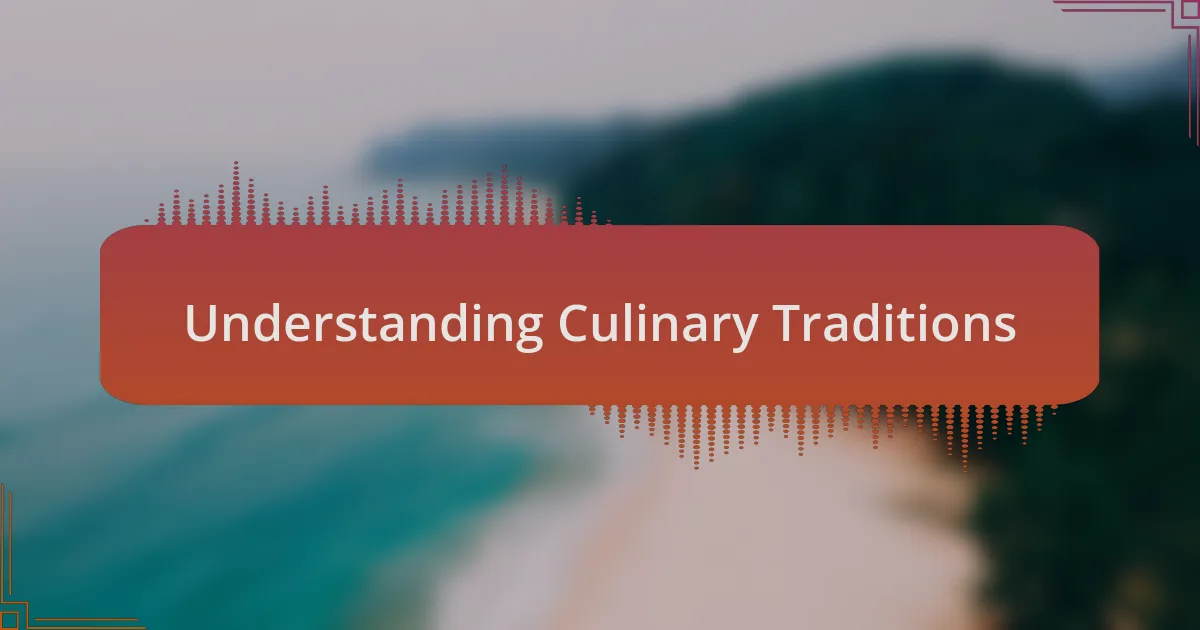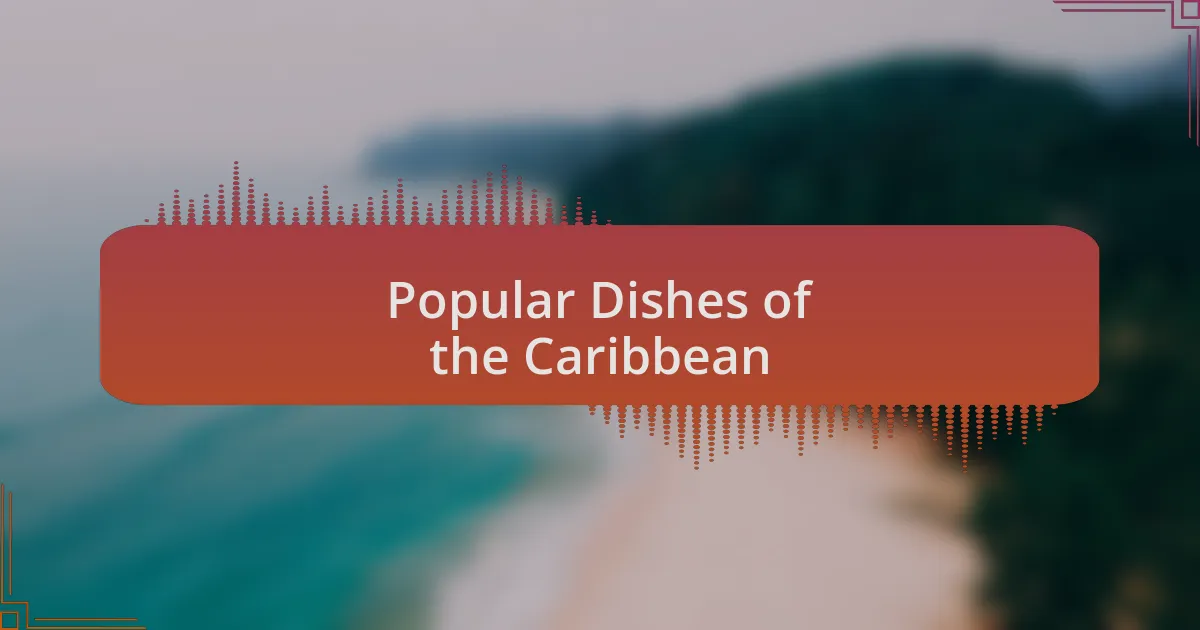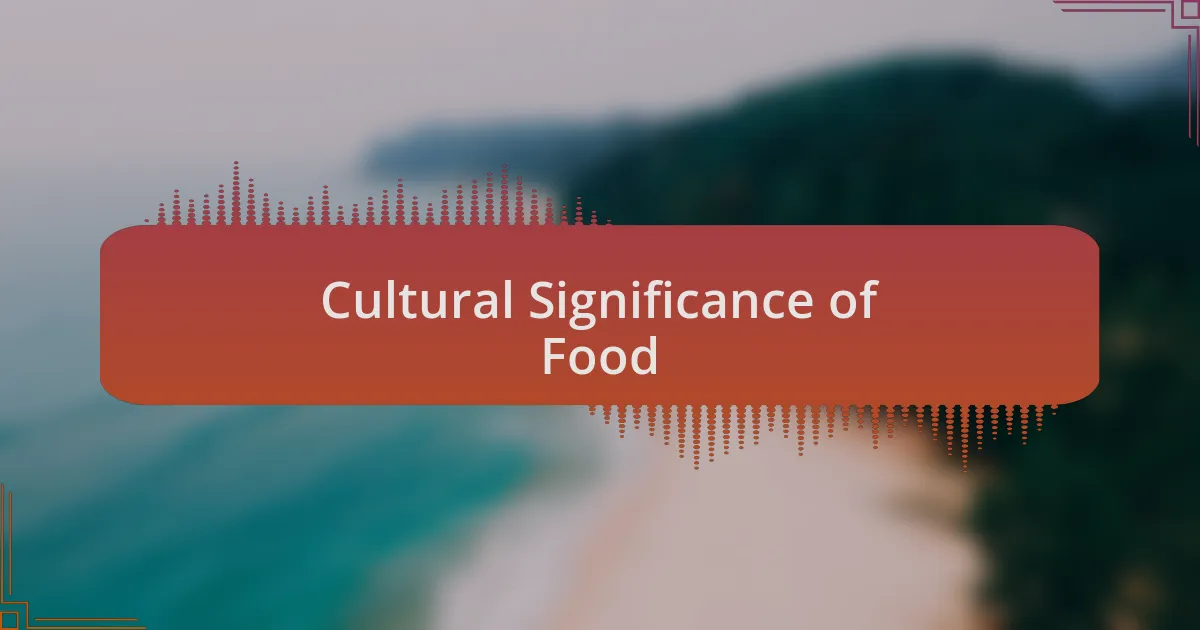Key takeaways:
- Culinary traditions embody history, culture, and personal memories, creating connections and evoking nostalgia.
- Caribbean cuisine reflects diverse influences and serves as a bridge to heritage and community through shared meals.
- Local ingredients play a crucial role in enhancing flavors and fostering connections among people.
- Food is a vibrant expression of cultural identity, with each dish carrying stories of ancestry and community.

Understanding Culinary Traditions
Culinary traditions are more than just recipes; they’re a rich tapestry woven with history, culture, and personal memories. I remember the first time I cooked with a local chef at a Caribbean resort. The way she mixed spices was almost like an art form, each ingredient telling a story of the island’s history and the influences of various cultures that have settled there.
What strikes me most about exploring these traditions is how they evoke nostalgia and connection. When I’m tasting a dish, I often wonder what memories it stirs for others. Could that spice remind them of their grandmother’s kitchen? For me, trying jerk chicken for the first time was a revelation, a burst of flavor that instantly transported me back to that vibrant market where the scents of grilling meats danced in the air.
As I delved deeper into Caribbean culinary traditions, I realized that every dish has a purpose, often reflecting the community’s values and celebrations. I can still visualize the lively celebrations where food served as a centerpiece, bringing people together. Isn’t it fascinating how a single meal can create bonds, evoke laughter, and preserve heritage? This is the heart of cuisine; it invites us to savor not just flavors but also the stories that unite us.

Exploring Caribbean Cuisine
Exploring Caribbean cuisine feels like embarking on a delightful journey for the senses. One evening, I joined a local family for a traditional cookout. As the sun set, the savory aroma of callaloo and the sizzle of fresh seafood on the grill engulfed me. It’s not just the food; it’s the laughter and stories shared over the meal that linger in my mind.
The vibrant colors and bold flavors of dishes like curry goat and plantain have a way of captivating my heart. I remember the first time I tasted a perfectly ripe mango, bursting with juice. It made me ponder—how does something so simple evoke such happiness? In that moment, I understood that food transcends mere sustenance; it’s a bridge to heritage and community.
With each bite, I discover not just flavors, but the history behind them. The fusion of African, European, and Indigenous influences is evident in every dish, reflecting a complex narrative. I often find myself asking, how did these diverse influences shape the dishes I now cherish? Engaging with Caribbean cuisine is more than about satisfying hunger; it’s about understanding the spirit of the islands and forging connections through shared experiences.

Popular Dishes of the Caribbean
One of the standout dishes that I encountered was jerk chicken. The first time I bit into it, I was taken aback by the smoky, spicy flavor that danced on my palate. It’s amazing how a simple combination of chili peppers, thyme, and allspice can create such an unforgettable experience. I often wonder how this method of cooking, with roots tracing back to the Maroons, has become a symbol of Caribbean food culture.
Then there’s the delightful seafood escovitch, which I tried at a charming seaside shack. The crispy fish topped with a tangy pickle of carrots and onions served as a reminder of the ocean surrounding the islands. What struck me most was how this dish exemplified freshness—each ingredient seemed to sing with the essence of the sea! Have you ever tasted something so fresh it makes you feel like you’re right there, in the moment? That’s what escovitch did for me.
Another striking dish is roti, which I enjoyed during a bustling street market visit. The flaky, warm bread wrapped around curried meats or vegetables felt like a warm hug for the soul. I can still recall the laughter and chatter around me while savoring each bite; it was a celebration of flavor and community. Does food truly have the ability to connect us in ways we often overlook? In the Caribbean, it certainly does, weaving stories and memories into every meal.

Influence of Local Ingredients
When I first ventured into a local market, I was struck by the vibrant colors and intoxicating aromas of fresh produce. The ripe tomatoes, sweet plantains, and fragrant herbs all beckoned for attention, and I couldn’t resist the urge to taste. What I found particularly fascinating was how these ingredients tell a story of the land and its people; each flavorful bite connects you to the soil and the sun that nurtured them.
My culinary journey led me to a small family-run restaurant where I learned the significance of local spices. The chef proudly shared how their unique blend was crafted from herbs grown right outside their kitchen window. I can still feel the warmth of their hospitality as I tasted the spices on my plate, each one adding depth and character to the dish. Doesn’t it make you ponder how local practices create layers of flavor that can’t be replicated elsewhere?
During a food festival, I encountered an impressive display of dishes celebrating the bounty of seasonal ingredients. There was something magical about enjoying a meal made from fresh, locally-sourced components. I remember sharing a table with strangers who quickly became friends, united by the experience of savoring dishes that captured the essence of the Caribbean. Have you ever felt that a meal could not only fill your stomach but also forge connections? That’s the power of local ingredients—they nourish both the body and the soul.

Cultural Significance of Food
Food is much more than sustenance; it’s a vibrant expression of culture and tradition. I recall attending a family gathering where dishes were passed around, each one steeped in history and rich with meaning. As I bit into the savory jerk chicken, I couldn’t help but appreciate how these flavors reflected generations of culinary knowledge and practice. Isn’t it incredible how a simple meal can tell tales of ancestry and community?
One afternoon, I joined a cooking class that focused on traditional Caribbean dishes. The instructor shared stories behind each recipe, emphasizing how specific preparations have been preserved through time. It was eye-opening to realize that the way we prepare food can hold the essence of cultural identity. I found myself questioning—how often do we overlook the roots of what we eat? Those stories transform meals from a mundane experience into a tapestry of cultural significance.
Sharing food often transcends mere consumption; it’s about connections and shared experiences. I remember sitting around a vibrant table adorned with various dishes, and it felt like we were all ambassadors of our own cultures. As laughter mingled with the aroma of spiced rice and fish, I understood how food fosters community and mutual respect. Doesn’t it warm your heart to think that every bite of food carries with it not just flavor but also a legacy of togetherness?

My Personal Culinary Journey
The journey through culinary traditions has been nothing short of transformative for me. I vividly remember the first time I tasted conch fritters while sitting on a beach, the sun melting into the horizon. The crunch and the burst of flavors danced on my palate, evoking memories of carefree summer days. It made me realize that food, especially in the Caribbean, serves as a bridge to joy, connecting us to the land and sea.
When I decided to delve deeper into these culinary customs, I faced countless recipes that seemed intimidating at first. I recall standing in my kitchen, surrounded by spices I had never even heard of—all for a traditional rum punch. I learned that each ingredient had a story, just waiting to be uncovered—a testament to how creativity and culture can blend. Isn’t it fascinating how taking a step back can revolutionize our appreciation for a dish?
Exploring my culinary heritage, I often found myself in the kitchens of local cooks, absorbing their techniques and insights as if they were treasured secrets. One day, a grandmother took my hand as we formed her famous dumplings together. The joy in her eyes as she shared the importance of each pinch of salt struck a chord in me. In those moments, I pondered—how much of our culinary history lies in the shared wisdom of generations? Each bite we take is a reminder that we are part of something larger, a vibrant history of flavors and traditions.

Tips for Experiencing Culinary Traditions
To fully embrace the culinary traditions of the Caribbean, I recommend immersing yourself in local markets. While wandering through vibrant stalls, I often felt the pulse of the culture—vendors chatting, music playing, and the rich aroma of spices enveloping me. Have you ever taken a moment to chat with a local about their favorite dish? Hearing their stories adds depth to the flavors you’ll taste later.
Participating in cooking classes can also enhance your experience dramatically. I remember joining a session that focused on preparing jerk chicken, where the chef shared not just the recipe, but the history behind each spice used. I found myself captivated by how food can narrate tales of migration, survival, and celebration. Isn’t it incredible to think that every sprinkle of seasoning is a nod to history?
Lastly, don’t shy away from trying street food. One evening, I tried a plate of fish tacos from a small cart at a local festival, and the explosion of flavors in my mouth was a reminder of how much authenticity there is in simplicity. Wouldn’t it be great if we all ventured outside our comfort zones more often? Embracing these moments can lead to surprising finds and a deeper love for the culinary landscape of the Caribbean.